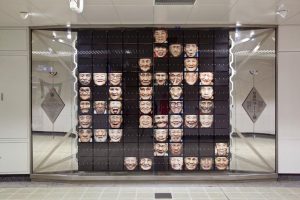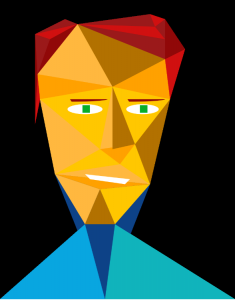//Jessica Timczyk
//Section D
//jtimczyk@andrew.cmu.edu
//project-01
function setup() {
createCanvas(900, 600);
background(255);
}
function draw() {
//eyeliner
noStroke();
fill(0);
curveTightness(.5);
beginShape();
curveVertex(372, 170);
curveVertex(372, 170);
curveVertex(367, 154);
curveVertex(397, 127);
curveVertex(441, 122);
curveVertex(414, 118);
curveVertex(392, 122);
curveVertex(372, 138);
curveVertex(361, 150);
curveVertex(361, 150);
endShape();
//eyelash 1
noStroke();
fill(0);
curveTightness(.5);
beginShape();
curveVertex(441, 122);
curveVertex(441, 122);
curveVertex(460, 110);
curveVertex(472, 96);
curveVertex(453, 110);
curveVertex(432, 120);
curveVertex(432, 120);
endShape();
// eyelash 2
noStroke();
fill(0);
curveTightness(.5);
beginShape();
curveVertex(436, 120);
curveVertex(436, 120);
curveVertex(445, 104);
curveVertex(444, 89);
curveVertex(439, 103);
curveVertex(426, 120);
curveVertex(426, 120);
endShape();
//eyelash 3
noStroke();
fill(0);
curveTightness(.5);
beginShape();
curveVertex(427, 120);
curveVertex(427, 120);
curveVertex(433, 100);
curveVertex(429, 88);
curveVertex(427, 104);
curveVertex(417, 119);
curveVertex(417, 119);
endShape();
//eyelash 4
noStroke();
fill(0);
curveTightness(.5);
beginShape();
curveVertex(414, 118);
curveVertex(414, 118);
curveVertex(418, 105);
curveVertex(414, 92);
curveVertex(410, 110);
curveVertex(400, 123);
curveVertex(400, 123);
endShape();
//eyelash 5
noStroke();
fill(0);
curveTightness(.5);
beginShape();
curveVertex(396, 125);
curveVertex(396, 125);
curveVertex(398, 112);
curveVertex(392, 103);
curveVertex(391, 117);
curveVertex(387, 127);
curveVertex(387, 127);
endShape();
//eyelash 6
noStroke();
fill(0);
curveTightness(.5);
beginShape();
curveVertex(382, 131);
curveVertex(382, 131);
curveVertex(381, 122);
curveVertex(371, 113);
curveVertex(373, 130);
curveVertex(372, 140);
curveVertex(372, 140);
endShape();
//eyelash 7
noStroke();
fill(0);
curveTightness(.5);
beginShape();
curveVertex(372, 142);
curveVertex(372, 142);
curveVertex(367, 134);
curveVertex(361, 130);
curveVertex(364, 141);
curveVertex(363, 154);
curveVertex(363, 154);
endShape();
// iris
noFill();
strokeWeight(3);
stroke(0);
curveTightness(.5);
beginShape();
curveVertex(383, 136);
curveVertex(383, 136);
curveVertex(393, 144);
curveVertex(407, 143);
curveVertex(413, 135);
curveVertex(414, 127);
curveVertex(410, 132);
curveVertex(400, 134);
curveVertex(393, 126);
curveVertex(393, 126);
endShape();
// bottom eyelid
curveTightness(.5);
beginShape();
curveVertex(440, 120);
curveVertex(440, 120);
curveVertex(435, 132);
curveVertex(426, 142);
curveVertex(415, 152);
curveVertex(432, 142);
curveVertex(441, 132);
curveVertex(445, 120);
endShape();
// eyebrow
fill(0);
noStroke();
curveTightness(.7);
beginShape();
curveVertex(327, 122);
curveVertex(327, 122);
curveVertex(356, 95);
curveVertex(395, 72);
curveVertex(423, 66);
curveVertex(454, 68);
curveVertex(424, 52);
curveVertex(401, 49);
curveVertex(378, 58);
curveVertex(355, 74);
curveVertex(334, 91);
curveVertex(320, 105);
curveVertex(320, 105);
endShape();
//eyebrow shadow
fill(151, 149, 148);
curveTightness(.25);
beginShape();
curveVertex(350, 119);
curveVertex(350, 119);
curveVertex(330, 137);
curveVertex(325, 149);
curveVertex(326, 162);
curveVertex(333, 169);
curveVertex(341, 175);
curveVertex(359, 189);
curveVertex(350, 170);
curveVertex(343, 153);
curveVertex(345, 136);
curveVertex(345, 136);
endShape();
//under eye shadow 1
fill(83, 82, 82);
curveTightness(.25);
beginShape();
curveVertex(410, 189);
curveVertex(410, 189);
curveVertex(444, 165);
curveVertex(470, 141);
curveVertex(469, 182);
curveVertex(463, 214);
curveVertex(438, 200);
curveVertex(438, 200);
endShape();
//cheak shadow
fill(0);
curveTightness(.25);
beginShape();
curveVertex(501, 74);
curveVertex(501, 74);
curveVertex(507, 75);
curveVertex(511, 86);
curveVertex(516, 100);
curveVertex(524, 115);
curveVertex(537, 130);
curveVertex(548, 146);
curveVertex(560, 168);
curveVertex(564, 179);
curveVertex(565, 192);
curveVertex(567, 202);
curveVertex(570, 212);
curveVertex(578, 228);
curveVertex(586, 242);
curveVertex(588, 248);
curveVertex(587, 254);
curveVertex(581, 244);
curveVertex(564, 232);
curveVertex(547, 222);
curveVertex(536, 219);
curveVertex(527, 221);
curveVertex(518, 223);
curveVertex(508, 225);
curveVertex(498, 225);
curveVertex(490, 224);
curveVertex(482, 222);
curveVertex(477, 218);
curveVertex(486, 209);
curveVertex(498, 191);
curveVertex(509, 172);
curveVertex(513, 157);
curveVertex(515, 143);
curveVertex(513, 125);
curveVertex(509, 108);
curveVertex(502, 88);
curveVertex(502, 88);
endShape();
//nose line
curveTightness(1);
beginShape();
curveVertex(301, 152);
curveVertex(301, 152);
curveVertex(309, 169);
curveVertex(325, 182);
curveVertex(346, 199);
curveVertex(360, 210);
curveVertex(374, 211);
curveVertex(374, 211);
endShape();
//right nostril
curveTightness(.5);
beginShape();
curveVertex(387, 226);
curveVertex(387, 226);
curveVertex(397, 226);
curveVertex(406, 228);
curveVertex(418, 235);
curveVertex(417, 245);
curveVertex(415, 251);
curveVertex(410, 256);
curveVertex(403, 259);
curveVertex(396, 258);
curveVertex(395, 247);
curveVertex(394, 235);
curveVertex(394, 235);
endShape();
//nose button
fill(151, 149, 148);
beginShape();
curveVertex(330, 213);
curveVertex(330, 213);
curveVertex(345, 231);
curveVertex(356, 246);
curveVertex(361, 263);
curveVertex(368, 261);
curveVertex(377, 258);
curveVertex(383, 250);
curveVertex(383, 242);
curveVertex(379, 237);
curveVertex(363, 230);
curveVertex(360, 228);
curveVertex(360, 228);
endShape();
//left nostril
fill(0);
beginShape();
curveVertex(375, 279);
curveVertex(375, 279);
curveVertex(357, 281);
curveVertex(356, 295);
curveVertex(366, 297);
curveVertex(376, 286);
curveVertex(376, 286);
endShape();
//left nose shadow
fill(0);
beginShape();
curveVertex(286, 203);
curveVertex(286, 203);
curveVertex(299, 204);
curveVertex(314, 214);
curveVertex(326, 227);
curveVertex(342, 248);
curveVertex(343, 272);
curveVertex(341, 291);
curveVertex(334, 284);
curveVertex(324, 251);
curveVertex(305, 224);
curveVertex(305, 224);
endShape();
//lip shadow
beginShape();
curveVertex(402, 268);
curveVertex(402, 268);
curveVertex(415, 282);
curveVertex(424, 285);
curveVertex(444, 268);
curveVertex(422, 269);
curveVertex(422, 269);
endShape();
//lip
curveTightness(0);
beginShape();
curveVertex(510, 274);
curveVertex(510, 274);
curveVertex(460, 277);
curveVertex(429, 287);
curveVertex(423, 299);
curveVertex(411, 302);
curveVertex(396, 328);
curveVertex(387, 362);
curveVertex(401, 372);
curveVertex(430, 370);
curveVertex(473, 357);
curveVertex(500, 326);
curveVertex(512, 297);
curveVertex(512, 297);
endShape();
//chin shadow
beginShape();
curveVertex(578, 315);
curveVertex(578, 315);
curveVertex(550, 385);
curveVertex(530, 411);
curveVertex(462, 432);
curveVertex(494, 438);
curveVertex(554, 444);
curveVertex(570, 428);
curveVertex(583, 379);
curveVertex(583, 379);
endShape();
//left cheek shadow
beginShape();
curveVertex(252, 324);
curveVertex(252, 324);
curveVertex(264, 345);
curveVertex(273, 358);
curveVertex(292, 368);
curveVertex(310, 380);
curveVertex(319, 393);
curveVertex(330, 402);
curveVertex(349, 412);
curveVertex(372, 411);
curveVertex(351, 399);
curveVertex(337, 382);
curveVertex(333, 365);
curveVertex(322, 356);
curveVertex(294, 344);
curveVertex(270, 335);
curveVertex(270, 335);
endShape();
//neck
beginShape();
curveVertex(479, 468);
curveVertex(479, 468);
curveVertex(521, 486);
curveVertex(550, 504);
curveVertex(559, 527);
curveVertex(530, 569);
curveVertex(498, 600);
curveVertex(521, 548);
curveVertex(527, 522);
curveVertex(516, 506);
curveVertex(516, 506);
endShape();
//hair
fill(150);
noStroke();
beginShape();
curveVertex(249, 70);
curveVertex(249, 70);
curveVertex(267, 115);
curveVertex(284, 184);
curveVertex(288, 256);
curveVertex(254, 325);
curveVertex(225, 368);
curveVertex(227, 407);
curveVertex(263, 433);
curveVertex(288, 413);
curveVertex(284, 401);
curveVertex(296, 414);
curveVertex(300, 438);
curveVertex(293, 458);
curveVertex(263, 474);
curveVertex(222, 458);
curveVertex(241, 499);
curveVertex(287, 534);
curveVertex(354, 556);
curveVertex(382, 600);
curveVertex(194, 600);
curveVertex(190, 551);
curveVertex(167, 518);
curveVertex(134, 492);
curveVertex(121, 424);
curveVertex(130, 378);
curveVertex(175, 325);
curveVertex(187, 271);
curveVertex(154, 200);
curveVertex(125, 135);
curveVertex(137, 73);
curveVertex(189, 49);
curveVertex(236, 55);
curveVertex(236, 55);
endShape();
//right lip accent
fill(0);
beginShape();
curveVertex(443, 308);
curveVertex(443, 308);
curveVertex(450, 310);
curveVertex(459, 311);
curveVertex(474, 293);
curveVertex(487, 285);
curveVertex(467, 285);
curveVertex(454, 290);
curveVertex(447, 291);
curveVertex(444, 298);
curveVertex(444, 298);
endShape();
//left lip accent
beginShape();
curveVertex(432, 317);
curveVertex(432, 317);
curveVertex(421, 313);
curveVertex(415, 324);
curveVertex(402, 347);
curveVertex(417, 336);
curveVertex(430, 328);
curveVertex(430, 328);
endShape();
//bottom lip accent
fill(122, 122, 122);
beginShape();
curveVertex(407, 361);
curveVertex(407, 361);
curveVertex(434, 360);
curveVertex(466, 350);
curveVertex(488, 329);
curveVertex(497, 303);
curveVertex(494, 297);
curveVertex(487, 301);
curveVertex(471, 319);
curveVertex(463, 322);
curveVertex(462, 328);
curveVertex(453, 328);
curveVertex(447, 336);
curveVertex(441, 337);
curveVertex(436, 337);
curveVertex(425, 349);
curveVertex(425, 349);
endShape();
//right hair
fill(150);
beginShape();
curveVertex(222, 42);
curveVertex(222, 42);
curveVertex(249, 58);
curveVertex(288, 64);
curveVertex(335, 56);
curveVertex(371, 36);
curveVertex(423, 35);
curveVertex(448, 47);
curveVertex(476, 56);
curveVertex(494, 61);
curveVertex(539, 70);
curveVertex(593, 98);
curveVertex(600, 105);
curveVertex(600, 84);
curveVertex(572, 35);
curveVertex(261, 34);
curveVertex(261, 34);
endShape();
//tearduct
fill(0);
beginShape();
curveVertex(288, 224);
curveVertex(288, 224);
curveVertex(294, 230);
curveVertex(294, 231);
curveVertex(300, 227);
curveVertex(287, 225);
curveVertex(287, 225);
endShape();
}
While creating this piece I gained proficiency in implementing basic objects within p5.js. Entering immense amounts of coordinates for the complex facial shapes was tedious and by the end of the process I learned to create the shapes as efficiently as possible.
![[OLD FALL 2018] 15-104 • Introduction to Computing for Creative Practice](https://courses.ideate.cmu.edu/15-104/f2018/wp-content/uploads/2020/08/stop-banner.png)




